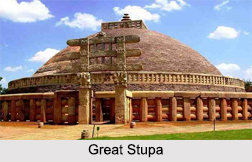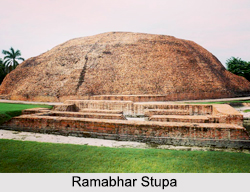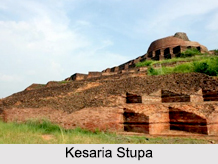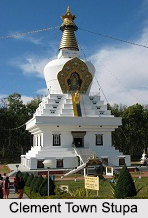 Buddha Stupas are the monuments raised to honour the spiritual teacher Lord Buddha who spread Buddhism across the world. The word "Stupa" is said to have been derived from the Sanskrit root "Stu" meaning "to worship" or "to praise". The Stupa is a semi-circular construction containing Buddhist remnants and place of deliberation used by the Buddhists monks.
Buddha Stupas are the monuments raised to honour the spiritual teacher Lord Buddha who spread Buddhism across the world. The word "Stupa" is said to have been derived from the Sanskrit root "Stu" meaning "to worship" or "to praise". The Stupa is a semi-circular construction containing Buddhist remnants and place of deliberation used by the Buddhists monks.
History of Buddha Stupas
The initial archaeological proof for the presence of Buddhist stupas dated to the late 4th century BCE. In India, Sanchi, Sarnath, Amaravati and Bharhut are among the oldest recognized stupas. The stupas were built with non-durable equipment such as wood. These stupas were built in Buddhist basic complexes and they reproduce in stone older stupas made of baked bricks and wood. According to Buddhist traditions, after attaining "Maha Nirvana" his body was cremated by the "Mallas of Kushinagar" with a royal ceremony befitting a universal king and the mortal remains were distributed among the 8 claimants including the Lichhavis of Vaishali. Seven others were "Ajatashatru"; the king of Magadha, "Sakyas" of Kapilavastu, "Bulis" of Alakappa, "Koliyas" of Ramagram, a "Brahmin" of Vethoweep and "Mallas" of Pava and "Kushinagar". However, its exteriors have a plain surface and are in a dilapidated condition.
Elements of Buddha Stupas
The stupas stand for the five purified elements and these are as follows:
•The square base symbolizes the earth.
•The hemispherical dome signifies water.
•The pointed spire represents fire.
•The higher lotus umbrella and the semi-circular moon stand for air.
•The sun and the dissolving point represent the part of space. 
Types of Buddha Stupas
Buddhist stupas are classified into five types:
•Relic Stupa: These are the stupas in which the remnants of the Buddha, his followers are interred.
•Object Stupa: These are the stupas in which the items interred are objects belonged to the Buddha or his disciples, such as a begging bowl or shawl and important Buddhist scriptures.
•Commemorative Stupa: These stupas were built to honour the incidents in the lives of Buddha or his followers.
•Symbolic Stupa: These stupas were built to represent the features of Buddhist religion.
•Votive Stupa: These stupas were created to increase the spiritual benefits.
Famous Buddha Stupas
Famous stupas in India are Sopara stupa, Great Stupa at Sanchi and Dhamek Stupa at Sarnath. Apart from the Pillar of Peace and the Ashokan Pillar, there are two more popular Buddha Stupas in the town of Vaishali. Vaishali, an ancient city in the state of Bihar, is the place where Gautama Buddha preached his last sermon before his death in CA 483 BCE. Other new and most famous Buddhist stupas are Deekshabhoomi Stupa, Bavikonda Stupa, Satdhara Stupas Monument, Sopara Stupa Mumbai, Buddha Memorial Park Stupa and 7 Peace Pagoda or Vishwa Shanti Stupa. Some of the famous Stupas found in India are as follows:
 Gorsam Chorten: The Gorsam Chorten is the major stupa of the area and is located at a distance of 90 kilometres from Tawang. It is considered to be founded by the Monpa monk, Lama Pradhar in the 12th century.
Gorsam Chorten: The Gorsam Chorten is the major stupa of the area and is located at a distance of 90 kilometres from Tawang. It is considered to be founded by the Monpa monk, Lama Pradhar in the 12th century.
Great Stupa: The Great Sanchi Stupa is one of the famous Stupa which is preserved in ancient stupas in India. It is also one of the oldest stone structures in India and also a significant Buddhist monument. The building work of this huge construction was commissioned by the king Ashoka the Great in the 3rd century BC and it was supervised by Ashoka"s wife.
Dhamekh Stupa: Dhamek Stupa lies at Sarnath in the Uttar Pradesh state of India. It is one of the holiest sites for Buddhist pilgrimage in India. Sarnath is well-known as the place where Lord Buddha had delivered his first speech after attaining the enlightenment at Bodhgaya.
Bavikonda Stupa: Bavikonda Stupa situated at 16 kilometres from Visakhapatnam, on a hill around 130 meters above mean sea level and is greatly significant Buddhist site.
Chaukhandi Stupa: This big, ruined stupa was originally built in the 4th and 6th centuries as a terraced temple in the Gupta era. Chaukhandi Stupa is one of the significant Buddhist Stupas at Sarnath which is also a popular tourist site in Uttar Pradesh.
Ramabhar Stupa: It is one of the most significant monuments in Kushinagar in Uttar Pradesh. The Ramabhar Stupa is more than 50 feet high and stands on a high mound which faces the road. It is the place where Lord Buddha was cremated and he reached salvation or Mahaparnirvana.
Kesaria Stupa: The Kesariya Stupa is devoted to Lord Buddha has a great importance and it is believed to dated back to somewhere between 200 AD and 750 AD. It is believed to have been built to honour the place where Lord Buddha had spent the last days of his voyage while preparing to achieve Nirvana.
Anathapindika Stupa: The Anathapindika Stupa is a stunning stupa built by one of the foremost disciples of Buddha. It is believed that Lord Buddha visited Shravasti at the invitation of Anathapindika.
Angulimala Stupa: Angulimala Stupa Shravasti is named after a dacoit, who was basically belonged to the searches of the social order.
Adurru Buddhist stupa: Adurru Buddhist stupa is a 2400 year old Buddhist site in Andhra Pradesh. The base of the stupa here was laid by Sanghamitta, Ashoka"s daughter on her way to Sri Lanka.
Animeshlocha Stupa: The Animeshlocha Stupa is situated on the north-east of the Mahabodhi Temple complex. There stands a statue of Buddha with his eyes fixed in the direction of the Bodhi tree.
Amaravati Stupa: Amaravati Stupa was one of the major in Andhra Pradesh with a length of 50 meters and a height of 27 meters but it has been destroyed. Much of the stone have been used by local outworkers in the 19th century.
 Maha Stupa at Thotlakonda: Thotlakonda Stupa is a famous Buddhist Gompa. It is situated in Visakhapatnam. It is believed to be a holy place of Buddhists in 300 BC to 300 AD. The place was discovered by the Indian Navy in 1976 throughout a mid-air survey.
Maha Stupa at Thotlakonda: Thotlakonda Stupa is a famous Buddhist Gompa. It is situated in Visakhapatnam. It is believed to be a holy place of Buddhists in 300 BC to 300 AD. The place was discovered by the Indian Navy in 1976 throughout a mid-air survey.
Shanti Stupa at Dhauligiri: Dhauli Giri Shanti Stupa is also known as Peace Pagoda. It is a Buddhist construction built in 1972 by the Japan Buddha Sangh and the Kalinga Nippon Buddha Sangh. It is situated in the middle of the presumed site of Kalinga War in Dhauli Hill in Odisha.
Stupa at Deorkothar: Stupa at Deorkothar is famous for its Buddhist stupas and was discovered in 1982. These stupas are credited to the Mauryan king, Ashoka.
Bharhut Stupa: Bharhut Stupa is located between Jabalpur and Allahabad in the former Nagod state of Madhya Pradesh. It was built in 3rd century BCE and in 1873 the place was discovered by Sir Alexander Cunningham.
Shanti Stupa at Leh: It is situated at the top of hill of Chamspa in Leh. It is one of the main tourist attractions of Ladakh not only for its spiritual importance for also for its fabulous views of the surrounding mountain ranges that it has to present.
Dro-dul Chorten Stupa: The stupa is enclosed by 108 prayer wheels all of which have mantras decorated on them in Tibetan. The stupa was built by Trulshik Rinpoche who was the head of the Nyingma order of Tibetan Buddhism in 1945.
Namgyalma Stupa: The Namgyalma Stupa is a Buddhist memorial honouring those who lost their lives in the freedom struggle for Tibet. The beautiful structure is surrounded by the prayer wheels.
Clement Town Stupa: The Clement Town Stupa was constructed for world reconciliation. It is 185 ft in span and 100 sq ft in width. A two-acre lush green garden encloses the wonderful stupa. The art work of the stupa is a splendid example of Buddhist art.
Smriti Park Stupa: The Buddha Smriti Park is located in front of the Patna Junction and it was inaugurated by Dalai Lama on the birth anniversary of the Lord Buddha.



















